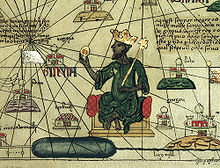Mansa Musa

Kankan Mansa Musa I († 1332 or 1337 ) was king or Mansa of Mali , the largest empire in West African history , from 1307 or 1312 until his death . Under his rule the country flourished and Timbuktu became one of the most important cities in Africa.
Life
Mansa (King) Musa was considered the "richest man of his time". His Hajj , the traditional Muslim pilgrimage to Mecca , became legendary with a length of around 7000 km in the years 1324/25. The fabulously wealthy king spent so much gold on the trip that in Cairo , Egypt , it ruined the value of the gold-based Egyptian dinar for ten years - it fell by a quarter of its value. Mansa Musa himself felt this on his return journey. Since his gold no longer had its original value, he had to borrow money from Cairo merchants.
A source for the Damascus- born Arab historian Shibāb al-ʿUmarī (1301–1349) stated: “The Sultan Musa told me that he had the exclusive right to the gold and that he would collect it as a tribute, except for what the Residents of the country take away what is theft. ”Al-Umari reports that the king's entourage allegedly consisted of 60,000 people - including 12,000 slaves - and that 80 camels carried 300 pounds of gold each.
Mansa Musa is considered to be the initiator and builder of the Djinger-ber Friday mosque in Timbuktu. Mansa Musa died in 1332 or 1337, and was succeeded by Mansa Magha .
In newspaper articles and on business news websites, Mansa Musa is often referred to as the richest person of all time, and his fortune, adjusted for inflation, is extrapolated to $ 400 billion. This assessment, which comes from journalists, is only found sporadically in the literature.
See also
literature
- Khephra Burns, Leo Dillon, Diane Dillon: Mansa Musa. The lion of Mali. Harcourt Brace, San Diego 2001, ISBN 0-15-200375-4 .
- Peggy Pancella: Mansa Musa. Ruler of Ancient Mali. Heinemann Library, Chicago 2003, ISBN 1403437033 .
- Rudolf Fischer: Gold, Salt and Slaves. The history of the great Sudan empires of Gana, Mali and Son Ghau. Edition Piscator, Feldbrunnen 2013, ISBN 978-3-906090-42-9 , pp. 95ff.
Web links
Individual evidence
- ↑ Excerpt from the illustration comes from this map: Original in the French National Library ( Memento from July 12, 2005 in the Internet Archive )
- ↑ Lutz van Dick, Martin Cohen, Dennis Doe Tamakloe (eds.): The history of Africa. Campus Verlag, 2004, ISBN 3593371014 , p. 69.
- ↑ a b Rudolf Fischer: Gold, Salt and Slaves. The history of the great Sudanese empires of Gana, Mali and Son Ghau. Edition Piscator, Feldbrunnen 2013, ISBN 978-3-906090-42-9 , pp. 95ff.
- ↑ a b Mūsā I of Mali in the Encyclopædia Britannica.
- ↑ M. Angulu Onwuejeogwu, Bana Okpu, Chris Ebighgbo: African Civilizations. Origin, Growth, and Development. Uto Publications, Lagos 2000, ISBN 978-3353802 , p. 239.
- ^ Dorothee Gruner: The clay mosque on the Niger, documentation of a traditional building type. Steiner, Stuttgart 1990, ISBN 3-515-05357-3 , p. 298 ff.
-
↑ King Mansa Musa I - richest person of all time. Die Welt from October 19, 2012.
Meet Mansa Musa I of Mali - the richest human being in all history. The Independent of October 16, 2012. - ↑ Naima Mohamud: Mansa Musa: The richest man who ever lived. BBC News, March 10, 2019, accessed March 10, 2019 .
-
↑ Alex Perry: The Rift. A New Africa Breaks Free. Dispatches from a changing continent. Weidenfeld & Nicolson, London 2015, ISBN 978-0297871248 , online
Molefi Kete Asante: The History of Africa. The Quest for Eternal Harmony. Taylor and Francis, Hoboken 2014, ISBN 978-1135013493 , p. 120.
Nicholas Jubber: The Eight Lessons of the Desert. With the nomads of North Africa to Timbuktu. Dumont Reiseverlag, 2017, ISBN 978-3-616-49101-1 , p. 19.
| predecessor | Office | successor |
|---|---|---|
| Abubakari II |
Ruler of the Mali Empire 1312–1337 |
Mansa Magha |
| personal data | |
|---|---|
| SURNAME | Mansa Musa |
| ALTERNATIVE NAMES | Mansa Musa I .; Kankan Mansa Musa I .; Mansa Musa Keita |
| BRIEF DESCRIPTION | King of Mali |
| DATE OF BIRTH | 13th Century |
| DATE OF DEATH | 1332 or 1337 |